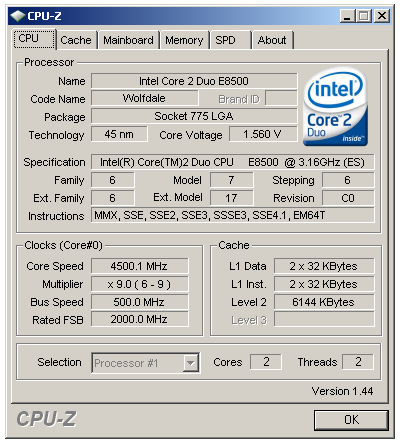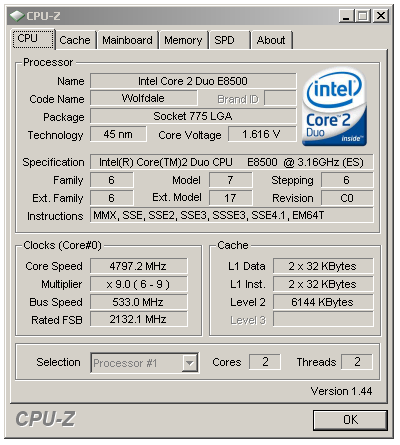Intel's 45nm Dual-Core E8500: The Best Just Got Better
by Kris Boughton on March 5, 2008 3:00 AM EST- Posted in
- CPUs
E8000 Lineup and Early Overclocking Results
Intel plans to introduce no fewer than four new 45nm dual-core processors as part of its Q1 2008 Wolfdale launch. At the time of publication, the following models are scheduled for immediate availability:
- E8200, 2.66GHz, 6MB shared L2 cache, 1333MHz FSB, maximum 8.0x multiplier
- E8300, 2.83GHz, 6MB shared L2 cache, 1333MHz FSB, maximum 8.5x multiplier
- E8400, 3.00GHz, 6MB shared L2 cache, 1333MHz FSB, maximum 9.0x multiplier
- E8500, 3.16GHz, 6MB shared L2 cache, 1333MHz FSB, maximum 9.5x multiplier
Estimated street prices, although unconfirmed and subject to change, are expected to be around $299 for the E8500, $249 for the E8400 and $163 for the E8200. As you can see, each processor features a maximum multiplier - there has been no formal mention of an "Extreme Edition" dual-core processor at this time. Additionally, rumors of the impending release of an E8600 processor (presumably running at 3.33GHz with a 10x multiplier) go unconfirmed. It it becomes available, the E8600 may very well be the CPU to own as it would allow for operation at 10x400 (4GHz), a very good place to be when it comes to tuning in maximum memory performance.
Unlike the Conroe release, all processors will make use of the full 6MB shared L2 cache offered on the top-end E8500 model. Undoubtedly, a 45nm Celeron or Pentium line (or E5000/E7000 - choose your favorite naming scheme) will eventually make their way to retail. We expect these to come in at 3MB and/or 1.5MB of shared L2 cache. Based on what we have seen when it comes to 65nm Pentium E2000 and Core 2 E4000 chips, when they do arrive the 45nm variants will offer tremendous value and an amazing price/performance ratio.
 Designed to run at an already fast 3.16GHz, this E8500 is just starting to stretch its legs and show its true potential with some water-cooling TLC. |
We were able to overclock our E8500 sample all the way to 4.5GHz with water-cooling; what's more, we were able to demonstrate complete stability at these speeds running many hours of Prime95, a popular tool for stress-testing systems. Most X6800/X6850 owners will attest to this amazing achievement - the average overclock for top-bin 65nm CPUs falls somewhere near the 3.8 ~ 4.0GHz mark. Results such as these combined with Wolfdale's modest clock-for-clock advantage over Conroe show the prospect of 15% or more processing power when overclocking. Even though the official frequencies may not have changed significantly (yet) - a new maximum of 3.16GHz, up from 3.00GHz - this increase in overclocking headroom makes the E8500 a marvel to behold.

Our top (unstable) overclock on water is nothing short of impressive. Although we were unable to benchmark up here, future steppings may change that. The ability to POST and load Windows at 4.8GHz on water promises more to come….
A quick maximum-frequency run on water indicates the proverbial sky's the limit when it comes to overclocking the E8500. The maximum achievable frequency had more to do with our nerves than anything else. Given the voltage, our E8500 was more than happy to continue scaling higher. However, we eventually said enough is enough and called it quits - that point came when we were subjecting our poor 45nm CPU to over 1.6V, a level that could possibly require you hand over your credit card number in exchange for another CPU in no time flat. Quite simply, we believe any voltage over 1.45V is asking for trouble with 45nm processors and our conversations with Intel to date have all but confirmed our suspicions.

The E8500 is no slouch when it comes to chasing a high FSB. Of course, all of this will be for naught when Intel releases their next-generation Nehalem architecture.
Here's the obligatory high-FSB screenshot, for those that care. In case you missed it, we recently had an in-depth article on why high FSB overclocking might not really be the best approach to take when dialing in maximum system performance. Suffice it to say, our fascination with these displays of CPU or motherboard worthiness is rapidly waning. However, we are also not so stubborn as to not acknowledge the importance of high FSB potential when it comes to pushing processors with low multipliers. Our recommendation is straightforward, however: buy the model with the highest multiplier that you can possibly afford. Most motherboards (and systems) are far happier running 9x490 than 8x550.










45 Comments
View All Comments
chizow - Wednesday, March 5, 2008 - link
Only had an issue with this statement:While this may be true for those building a new system around a new CPU, this might not hold true for those looking to overclock using an existing board. These 45nm CPUs with their higher stock 1333 FSB will by necessity use lower multipliers which essentially eats into potential FSB overclocks on FSB-limited chipsets. Considering many 6-series NV chipsets and boards will not support Penryn *at all* this is a very real consideration for those looking to upgrade to something faster.
Given my experiences with NV 6-series chipsets compared to reviews, I'm not overly optimistic about Penryn results on the 7-series either. Curious as to which board you tested these 45nm with? I haven't kept up with P35/X38 capabilities but the SS you showed had you dropping the multiplier which is a feature I thought was limited to NV chipsets? I might have missed it in the article, but clarification would be appreciated.
TheJian - Thursday, March 6, 2008 - link
I have a problem with this part of that statement "Intel has also worked hard to make all of this performance affordable." They forget it was AMD who forced Intel to cut margins on cpus from 62% (I think that was their high a few years back) to a meager 48% (if memory serves) and their profits to tank 60% in some quarters while driving AMD into the ground. Do they think they were doing it for our sakes? NOT. It was to kill AMD (and it worked). WE just got LUCKY.How much INTEL butt kissing can you do in one article? Notice that since AMD has sucked Intel is starting to make an ABOUT FACE on pricing. Server chips saw an increase of 20% about a month ago or so (it was written about everywhere). Now we see the E8400 which was $209 on newegg just a few weeks ago and IN STOCK, is said to go for $250 if you believe Anandtech. Even newegg has their future chips when they come back in stock now priced at $239. That's a $30 increase! What is that 14% or so? I missed the first E8400's and thought it would go down, instead Intel restricts volume and causes a price hike to soak us since AMD sucks now. I hope AMD puts out a decent chip shortly (phenom 3ghz would be a good start) so we can stop the price hikes.
What's funny to me is the reviewers let Intel get away with pricing in a review that comes nowhere near what it ACTUALLY debuts for. They've done the same for Nvidia also (not just anand, but others as well). The cards always end up being $50 more than MSRP. Which screws competitors because we all wait for said cheap cpu/gpu and end up not buying a very good alternative at the time (on the basis of false pricing from Intel/Nvidia). They should just start saying in reviews, "but expect $50 more upon debut than they say because they always LIE to get you to not buy the competitors product". That would at least be more accurate. For the record I just bought an 8800GT and will buy a wolfdate in a few weeks :) My problem here is the reviewers not calling them out on this crap. Why is that?
mindless1 - Wednesday, March 5, 2008 - link
Yes you are right that the higher default FSB works against them, it would be better if a Pentium or Celeron 45nm started with lower FSB so the chipsets had enough headroom for good overclock.NV is not the only one that can drop the multiplier, I've not tried it on X38 but have on P35 and see no reason why a motherboard manufacturer would drop such a desirable feature unless the board simply was barren of o'c features, something with OEM limited bios perhaps.
Psynaut - Wednesday, March 5, 2008 - link
It took me a minute to figure out that they were talking about the chips that were released 6-8 weeks ago.squito - Wednesday, March 5, 2008 - link
Same here ... maybe they need to be reintroduced?Johnbear007 - Wednesday, March 5, 2008 - link
Where in the U.S. do you see a Q6600 for under 200$???? I still see it at 245$ at newegg and your own anandtechshopping search doesn't come anywhere near the pricepoint you mention.XtAzY - Wednesday, March 5, 2008 - link
If you take a look at Hot Deals last month, you could have gotten a q6700 for $80http://hardforum.com/showpost.php?p=1032017513&...">http://hardforum.com/showpost.php?p=1032017513&...
but of course it's already over
smithkt - Wednesday, March 5, 2008 - link
That was for the e6700 not the q6700firewolfsm - Wednesday, March 5, 2008 - link
With core 2s, you can always do a minor frequency overclock while actually undervolting it. With a decent cooler, it could even last longer than stock.ap90033 - Wednesday, March 5, 2008 - link
Is it me or was this a little to negative on the OC stuff? I mean really, if you have good cooling, keep the voltage 1.44 or lower I bet the CPU would last 2-3 years or more...It almost sounds like they are marketing for Intel, "Great Overclokcer" but wait dont OC just get the highest model or it will only last 10 minutes!